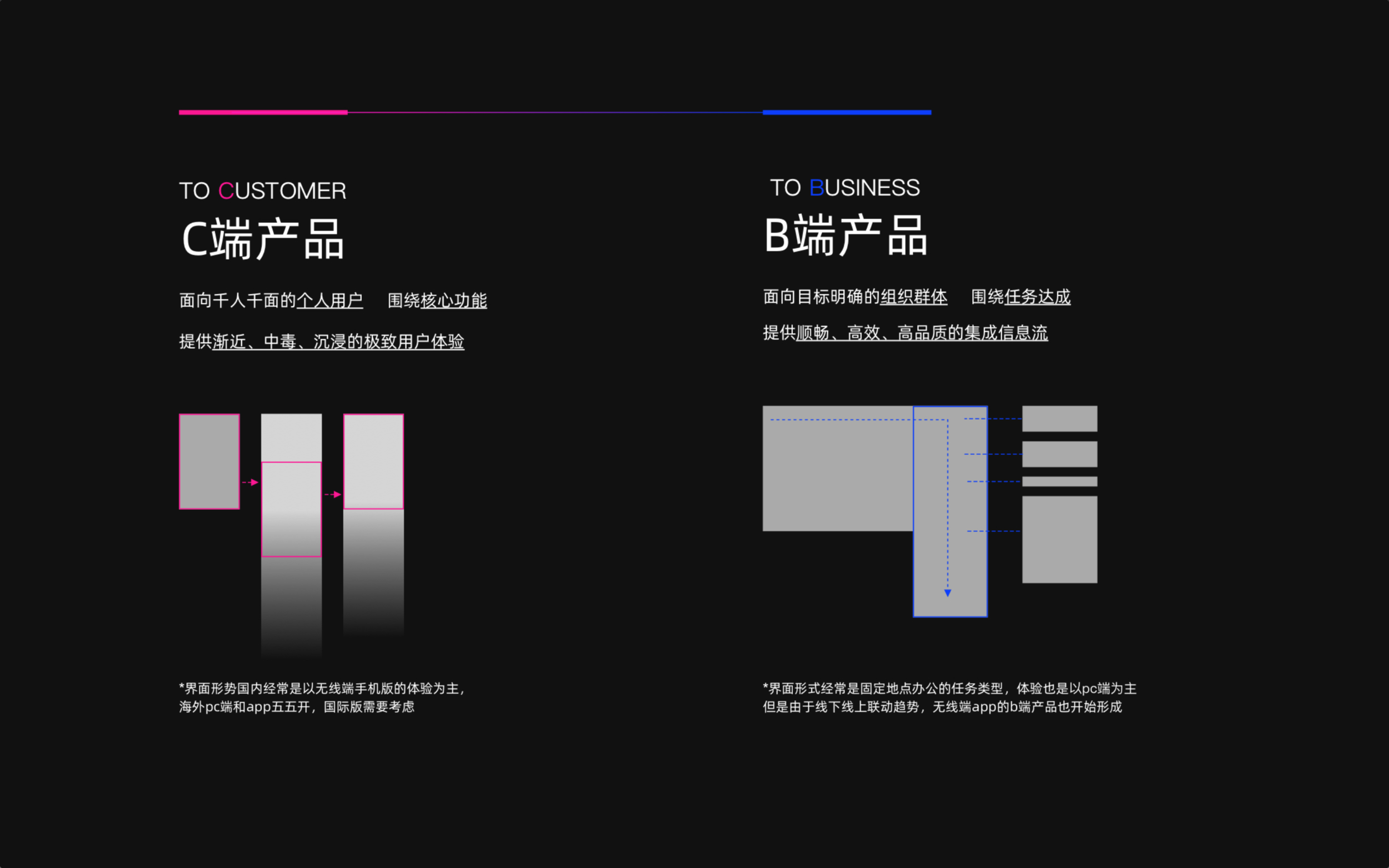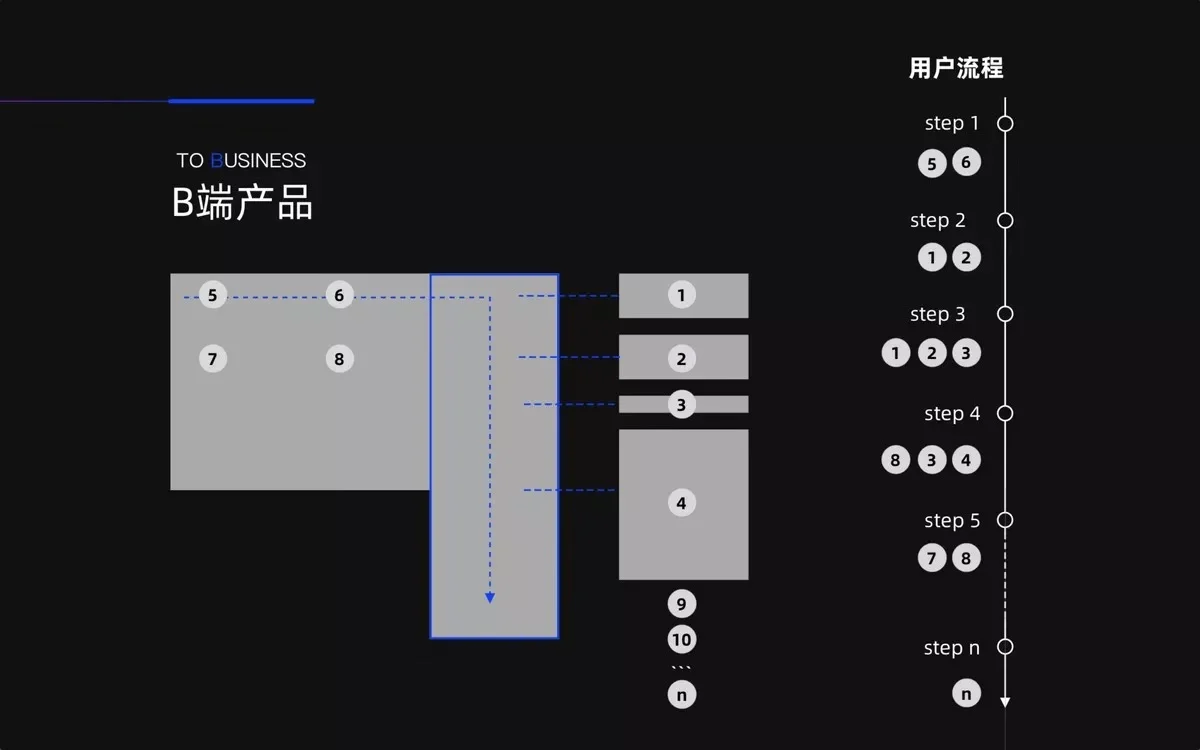How can newcomers quickly break into B-side thinking?
2019.08 Internship Reflection at Alibaba
一、总体了解
由于缺乏自身就是用户的第一视角的体感,再加上业务知识的门槛,我在进入b端领域之初,确实一开始觉得很难上手。接触下来,更觉得b端的设计不仅仅涉及到产品本身,更像是一种系统性的复杂生态。在这个生态系统里,不同的技能岗位都会需要深入所在的b端业务专业领域。作为设计师,在这样复杂的专业领域,快速切入b端思维是很必要的。
所以我做了以下几个步骤去帮助我探勘这个生态本身:
所以在我的认知里,b端中设计师是非常清楚每一个阶段每一个机会点,哪怕不是项目机会点洞察发起人,也一定是接到需求时毫不意外甚至是已经在心理盘了70%了,因为需求点仅仅是对上了无时无刻不在思考的盘点的大框架的其中之一而已。
1、了解业务:用户、客户、核心目标
大纲:借助什么样的工具、平台去帮助用户达成客户的什么样的业务任务,核心目标是什么;其中各个环节是什么,它们之间的关系是什么样的,目前的现状是什么
tips:找人聊是最快的能够获取这些高度总结的信息的最快方式(不要被限制在单点局部)
2、了解产品:承载这些的产品是什么
有了总的大纲后,继而去看待b端产品就会有一个总体和局部的对应关系。得到的视野也就不仅是界面层面的长成什么样,就继而能够把我界面模块带给用户的价值。把这些零散繁杂的模块进行信息架构层的归类,即能够得出清晰的产品模块梳理。
tips:看使用产品的录屏记录能够把这些产品功能代入真是具体场景中串联;另外看团队任务协同列表中其他团队成员对它的持续的需求名能够快速get这个产品的迭代历史和方向
二、全链路机会点盘点要置前(全局观、全流程)
b端产品每次给到的迭代需求可能看似细碎,但其实一步一步就是一个完整版的几点几版本的分步。我们体验设计师已经不再是等着需求提出到给我们才开始思考解法,其实是从接触这个业务就应该有一个全局的盘点,日常的迭代需求只是在不断在丰富全局盘点之下的细节推演、进度更新而已。
所以在我的认知里,b端中设计师是非常清楚每一个阶段每一个机会点,哪怕不是项目机会点洞察发起人,也一定是接到需求时毫不意外甚至是已经在心理盘了70%了,因为需求点仅仅是对上了无时无刻不在思考的盘点的大框架的其中之一而已。
1、WHY 为什么
虽然说可能盘点的代价投入是相对很高的,需要一个一个步骤一个一个阶段去拆解去归纳去总结,要花费很多的精力也可能没有立竿见影的大改动。但由于b端用户的稳定性和黏度天然地比c端要高很多,所以对于全链路的盘点是非常非常重要的,得出的系统化思考的结论也是相对稳定的,做这一步的是必须且高价值的,助于系统性地、可持续地、精准地推导出单点需求的解法。
2、HOW 方式
1)多角色纬度:搭建用户系统
2)根据中心任务,基于多角色调研结果、绘制用户地图
三、几点体会
1、能做个例,能不能想想规则
(1)对形式样式进行统一,是b端中后台设计师的必要能力
统一的容器不是僵硬的,需要根据实际情况进行调整。在真是落地场景中,有些时候没办法进行完全“干净”,需要针对当前业务平衡。
(2)以模块角度,对形式进行逻辑推敲
(3)授人以鱼,不如授人以渔
当按照形式做完,按照模块梳理完,在选用的过程中,其实是点状的,对后续的赋用缺乏指导性,其实给到的整理沉淀更好的方式应该是一套应该怎么用的方法论,所谓授人以鱼不如授人以渔。
b端产品引导的重要性毋庸置疑,我一开始的查找了很多互联网上的产品引导设计,大多数都是对于引导形式的枚举罗列,在发力点上过于零散,在策略上过于滞后,我觉得换个系统性的角度思考引导要长成什么样,会更加有整体感
2、能解当下,能不能从现象再往本质走一步
从需求出发,也许可以得到一个根据业务目标推导出来商业价值的关键词,也许再结合用户价值可以得到解析过的关键词,你以为这就达到本质了吗,其实再往本质走一步,可以挖出更大的天地。
比如:业务关键词——提效品质;客服用户价值——易学易上手。可能智能想到去做引导;但如果,再往本质看,其实是一个认知学习、信息结构的问题,这样就有了更大更深的发挥空间。
比如:业务关键词——外呼召回率;客服用户价值——移动版带来的工作地点的解放;如果再往本质看,工具从pc端到移动端的端与端的变化转化,的背后是人类社会的工作方式逐渐脱离固定物理空间的过程。从2g的固定网络的固定的工作生活方式,到4g移动场景所要当下我们面临的工作方式,那其实即将到来的5g所要匹配的下一代工作方式的场景探索是不是可以开始准备了呢?
3、能做设计,能不能打破边界从更广的视野看
设计师在这么大的天地里,能做的到底有哪些?能介入的阶段在哪里?
比如,在做智能推介的项目里,设计师对于项目的贡献只能由于技术的门槛做用户端形式的收口吗?
——不!在不被技能角色限制下,打破所谓的边界,设计其实有更多的发挥空间和价值
1)推介其实是在做信息流的匹配,设计能不能在信息流的最前端的匹配阶段就介入,从核心元点贡献
2)如果有很强的技术门槛介入很难,那有没有更多的工具类型的设计,形式不一定要只是被动吐出的模式类型
3)如果定义了工具类型,那给到用户的体验,从感知的角度,除了对样式的定义,那动效甚至是音效是怎么样,都是可以玩起来的
4、不要急着冲向结果,不要把结果当成终点
b端的项目会有很强的连贯性和周期性,很多时候一个大的战役目标是通过多次多点的需求慢慢攻破的,有破局和深耕的感觉。项目的过程,从了解到深入设计再到反馈,整个设计流程的闭环,都需要有计划有组织地跟进,以及在重要阶段节点的盘点也是很必要的。这些能力对于b端设计师很重要。
在实际工作中,当多条业务线并行的时候,项目管理、协同资源的能力就显得更加重要了。
结尾
设计师都不断地烧脑思考、不断地学习更新;不是对接了具体需求才开始解题,解题的“功夫”其实都在每一天。
对我来说,可能目前我解的答案结果不是很成熟也不是很完备,但是不断地去训练自己的思维方式,在真实的业务场景中去打磨检验自己的专业深度广度,我觉得是很有必要的。阶段性的复盘,浅谈自己的这段时间的思考和感悟。欢迎探讨~
1. Overall understanding
Due to the lack of the first-person perspective of the user, coupled with the threshold of business knowledge, when I entered the b-end field, I did find it difficult to get started at first. After getting in touch with it, I feel that the design of the b-side is not only related to the product itself, but more like a systematic and complex ecology. In this ecosystem, different skill positions will need to be in-depth in their B-side business professional fields. As a designer, in such a complex professional field, it is necessary to quickly enter into B-side thinking.
So I took the following steps to help me explore the ecosystem itself:
Therefore, in my opinion, designers in the B-side are very aware of every opportunity at every stage. Even if they are not the initiators of project opportunity insights, they must not be surprised when they receive the demand and may even have already thought about it mentally. 70%, because the demand point is just one part of the larger framework of inventory that I think about all the time.
1. Understand the business: users, customers, core goals
Outline: What tools and platforms are used to help users achieve what business tasks of customers, what are the core goals; what are the various links, what is the relationship between them, and what is the current status quo
Tips: Chatting with someone is the fastest way to obtain this highly summarized information (don’t be limited to a single point)
2. Understand the product: What is the product that carries these?
After having the general outline, when looking at b-end products, there will be an overall and partial correspondence. The obtained vision is not only what the interface looks like, but also the value that our interface module brings to users. By classifying these scattered and complicated modules into the information architecture layer, a clear product module can be sorted out.
Tips: Looking at the screen recording of using the product can put these product functions into a series of specific scenarios; in addition, looking at the names of other team members’ continued needs for it in the team task collaboration list can quickly get the iteration history and direction of this product.
2. Inventory of opportunity points across the entire link should be put first (overall view, whole process)
The iteration requirements given to b-end products each time may seem trivial, but in fact, step by step is a few steps of a complete version. We experience designers no longer wait for requirements to be presented to us before we start thinking about solutions. In fact, we should have an overall inventory from the moment we come into contact with this business. Daily iteration requirements are just a detailed deduction based on the continuous enrichment of the overall inventory. , progress update only.
Therefore, in my opinion, designers in the B-side are very aware of every opportunity at every stage. Even if they are not the initiators of project opportunity insights, they must not be surprised when they receive the demand and may even have already thought about it mentally. 70%, because the demand point is just one part of the larger framework of inventory that I think about all the time.
1. WHY Why
Although the cost of inventory may be relatively high, it requires dismantling and summarizing step by step, and it may take a lot of energy and may not result in any big changes immediately. However, since the stability and stickiness of b-side users are naturally much higher than that of c-side users, it is very, very important to take stock of the entire link, and the conclusion of systematic thinking is relatively stable. The person who does this step is Necessary and high-value, it helps to derive solutions to single-point requirements systematically, sustainably, and accurately.
2. HOW method
1) Multiple role dimensions: building a user system
2) According to the central task, draw a user map based on multi-role survey results
3. Some experiences
1. Can you give an example and think about the rules?
(1) Unifying forms and styles is a necessary ability for b-end mid- and back-end designers
The unified container is not rigid and needs to be adjusted according to the actual situation. In a real implementation scenario, sometimes it is impossible to be completely "clean" and it needs to be balanced according to the current business.
(2) From a module perspective, logically review the form
(3) It is better to teach people how to fish than to teach them how to fish.
When it is completed according to the form and sorted out according to the module, the selection process is actually point-like and lacks guidance for subsequent assignments. In fact, the better way of sorting and settling given should be a set of how to use it. Methodology, it is said that teaching a man to fish is worse than teaching him to fish.
There is no doubt about the importance of b-end product guidance. I initially searched for a lot of product guidance designs on the Internet. Most of them were enumerations of guidance forms, which were too fragmented in terms of efforts and too lagging behind in strategy. I think it will be more holistic if we think about what guidance should look like from a systematic perspective.
2. If you can understand the present moment, can you take one step further from the phenomenon to the essence?
Starting from the demand, you may be able to get a keyword with commercial value deduced based on the business goals. Maybe combined with the user value, you can get the analyzed keywords. Do you think this has reached the essence? In fact, if you go one step further to the essence, you can dig out Create a bigger world.
For example: business keywords - improving efficiency and quality; customer service user value - easy to learn and get started. Maybe the intelligence wants to do guidance; but if we look at the essence, it is actually a problem of cognitive learning and information structure, so there will be greater and deeper room for development.
For example: business keywords - outbound call recall rate; customer service user value - the liberation of the workplace brought by the mobile version; if we look at the essence, behind the end-to-end transformation of tools from PC to mobile is human beings. The way society works is gradually moving away from fixed physical spaces. From the fixed working lifestyle of the 2G fixed network to the working methods we are currently facing in the 4G mobile scenario, can we start to prepare for the scenario exploration of the next generation working methods that the upcoming 5G will match?
3. If you can design, can you break the boundaries and look at it from a wider perspective?
What can designers do in such a big world? Where is the stage for intervention?
For example, in a smart promotion project, can the designer's contribution to the project only be closed in the form of a client due to technical barriers?
--No! Without being limited by skills and roles, breaking the so-called boundaries, design actually has more room and value.
1) Promotion is actually about matching the information flow. Can the design intervene at the front-end matching stage of the information flow and contribute from the core elements?
2) If there is a strong technical threshold and it is difficult to intervene, then are there more tool-type designs? The form does not have to be just a pattern type that is passively spit out.
3) If the tool type is defined, the user experience will be given. From a perceptual perspective, in addition to the definition of style, the dynamic effects and even sound effects can be played.
4. Don’t rush towards the result, and don’t regard the result as the end point.
B-side projects will have strong continuity and periodicity. Many times, a large campaign goal is slowly overcome through multiple and multi-point demands, giving the feeling of breaking through and in-depth development. The project process, from understanding and in-depth design to feedback, the closed loop of the entire design process requires planned and organized follow-up, and inventory of nodes at important stages is also necessary. These abilities are very important for b-end designers.
In actual work, when multiple business lines are running in parallel, the ability to manage projects and coordinate resources becomes even more important.
conclusion
Designers are constantly burning their brains, thinking, learning and updating; they do not start solving problems only after meeting specific needs. The "effort" to solve problems is actually done every day.
For me, maybe the answers I have solved so far are not very mature or complete, but I think it is very useful to constantly train my way of thinking and polish and test my professional depth and breadth in real business scenarios. necessary. A periodic review, briefly talking about my thoughts and insights during this period. Welcome to discuss ~



